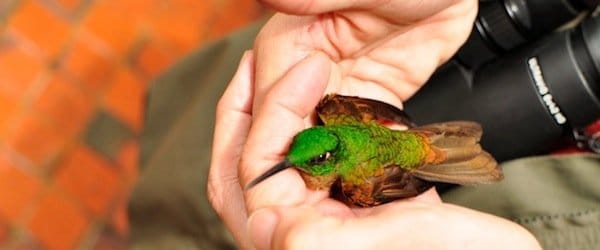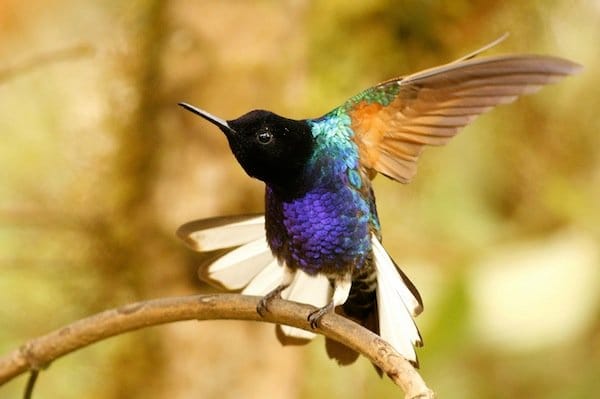Few living things are created perfect. But I think hummingbirds are as close to evolutionary perfection as one can get. These enchanting nectar feeders have truly mastered the art of flight like no other bird. A high metabolism and the ability to rotate their wings through 180 degrees enables these little gems to fly forward, backward and pretty much everything in between. But what is really remarkable about hummingbirds is the way that each particular species has filled its own niche in the constant battle for nectar. Collecting nectar is not a random occurrence. This is the story of the nectar wars from Tandayapa Lodge in north-west Ecuador.
 A Fawn-breasted Brilliant in the hand by Laura Kammermeier
A Fawn-breasted Brilliant in the hand by Laura Kammermeier
Tandayapa Lodge is hummingbird heaven. Nestled in cloud forest at 6000 feet on the western slope of northern Ecuador, this place is a true birding lodge with comfortable accommodations, excellent birding leaders and great tasting coffee. If you want to see a dazzling variety of hummingbird species in a short amount of time, then this is the lodge for you. Its not uncommon to see 14 of 15 different species at the hummingbird feeders before you have finished your morning cup of coffee.
 The beautiful but seldom-seen Velvet-purple Coronet by Luke Seitz
The beautiful but seldom-seen Velvet-purple Coronet by Luke Seitz
The battle for nectar is a complicated web of deceit, thievery, parasitism, and downright aggression. Watching different hummingbird species visiting a feeder, one would be tempted to think that the spectacle is a random coming and going of some beautiful shiny birds. In reality it is a highly organized snap-shot of the battle for survival that these beauties wage every day of their lives. Such is the variety of survival strategies employed by the hummingbirds that several authors have attempted to categorize them into well-defined groups. There are the highly organized trapliners, the aggressive turf protectors, the enterprising nectar burglars, the big bruisers and the deceitful parasites who ride on the success of others. And at Tandayapa Lodge you can view all of these strategies in action from your bedroom window or from the breakfast table.
Let’s start with the Turf Protectors. These are aggressive hummers who will actively try to defend a particular food source, constantly chasing away other hummingbirds and spending as much time defending a food source as they do eating it. They are mostly medium to large hummingbirds who do not give way to anyone, even the Big Bruisers. Examples of these at Tandayapa include the Buff-tailed Coronets and the Violet-ears. Here is the Buff-tailed Coronet…
httpvh://www.youtube.com/watch?v=HBRS7l6fXU4
Green, Sparkling and Brown Violetears visit the feeders at Tandayapa. This clip features a Green Violetear followed by a Brown Violetear…
httpvh://www.youtube.com/watch?v=MmMu3u6iZoE
But the Turf Protectors cannot multi-task so whilst they are feeding or chasing other hummingbirds, the little Territory Parasites will fly in and quickly steal some nectar or, in the case of a feeder, some sugar water. Purple-throated Woodstars with their erratic and elusive flight pattern are perfect examples of the little boys stealing from the big boys. It is even believed that some larger hummingbirds ignore them because of their bee-like behavior, perceiving them as little more than mildly annoying insects…
httpvh://www.youtube.com/watch?v=808Cdyaej1w
The Trapliners comprise of hummingbirds like incas and hermits. These hummingbirds have developed a highly organized strategy of nectar gathering. Rather than defending a particular shrub, flower or feeder, these birds visit a coordinated series of food sources over and over again as they complete their circuit of food “traps”. Once the circuit has been completed they start over again in a never-ending quest for sugar. The Brown Incas at Tandayapa are endemic to the Choco region and are dedicated Trapliners. In this video you will also see brief footage of the endearing Booted Racket-tails…
httpvh://www.youtube.com/watch?v=UfvizTb6dFY
Whilst hummingbirds are a wonderful example of near evolutionary perfection, the opposite holds true of Aderman, my videographer. There is no need for modern humans to be 6 ft 10. In past millennia, when there was more competition for food sources, he might have served a purpose gathering high-hanging fruit or browsing the tops of trees like a giraffe. But alas for Aderman no such need exists today. But if he were a hummingbird, his exceedingly large size might have its advantages…
 Aderman the Big Bruiser by Laura Kammermeier
Aderman the Big Bruiser by Laura Kammermeier
Enter the Big Bruisers. These are hummingbirds that are so big that they do not rely on any strategy besides knocking others out the way. The Big Bruisers are afraid of nobody. Even the aggressive attentions of the Turf Protectors do not bother them. They simply barge their way into a food source and feed until satisfied. Another Choco endemic, the stunning Empress Brilliant is a Big Bruiser with attitude and a good sense of dress-code (here joined by an Andean Emerald and a Purple-throated Woodstar)…
httpvh://www.youtube.com/watch?v=b0iOHOi_M08
And when you have neither the brute strength of the Big Bruisers, the cunning of the Territory Parasites, the energy of the Turf Protectors or the organizational skills of the Trapliners, you can always resort to thievery. The Wedge-billed Hummingbirds of Tandayapa bypass the evolutionary adaptation of the flower by piercing a hole at the base of the petals and stealing the nectar package that is concealed within. In so doing they are defeating the plant’s main aim which is to lure hummingbirds and insects past the pollen-carrying stamens of the flower to get at the hidden nectar. As well as employing criminal tactics to get ahead in life, the male Wedge-billed hummingbird also has a way with the ladies, parading and displaying like there is no tomorrow. Notice the tail display and the relatively short bill, perfect for piercing the bases of flowers…
httpvh://www.youtube.com/watch?v=DSudNRFkoRs
Hummingbirds are resilient creatures and some of them can be found way above the tree-line in the High Andes of Ecuador. In fact close to 20% of all bird species in high Andean environements are hummingbirds. This is one of the harshest environments on the planet with thin air, freezing temperatures and limited nectar supplies. But hummingbirds have adapted to life here by going into a state of torpor (temporary hibernation) at night, by diversifying their feeding strategies to include insects and by perching more often when feeding so as not to expend huge amounts of energy hovering in the rarified air. One species is found higher than all – right up to the snow at 17,000 feet – the Ecuadorian or Chimborazo Hillstar…
httpvh://www.youtube.com/watch?v=AWLyYw7LmQM
Arguably the most beautiful hummingbird at Tandayapa Lodge is the Violet-tailed Sylph, another endemic of the Choco region…
httpvh://www.youtube.com/watch?v=TFKuFxgwxC4
So if its hummingbirds you’re after you will struggle to find a more suitable destination than Tandayapa Lodge, Ecuador. Watch the full show here.













Hi James,
What a nice article ! For having already seen each species depicted within it (at Tandayapa or elsewhere), I’ve been very impressed by the good video footages and by your very bright presentation of the behavior of each species. I’ve been astonished to learn that nearly 20% of all the species found in the High Andes are hummingbirds species. It’s true to say that these fragile birds are by far more resiliant than they appear. It’s something to observe at Papallacta Pass, in Ecuador, the hummer with the longest bill of the world, the Sword-billed Hummingbird, chasing the insects on the wing and, soon after and a little bit higher in altitude, the hummer with the smallest bill in the world, the Purple-backed Thornbill. Yes, the hummingbirds are amazing and spectacular to observe in many ways.
Many thanks again and good birding.
@Laval Roy. Would have loved to see Sword-billed. My 2nd visit to Ecuador and I’ve still dipped on it. That looks like such a spectacular bird!
This was a treat. Thank you!
You are welcome! The birds make it easy…
Fascinating, and great to see good video footage of these lovely little birds. I’m heading to Ecuador (and beyond) in August and posts like this are both helpful and inspiring. Thanks James and Aderman!
Great post! I will be spending a week at the lodge here August 10-17, 2014.
You fired me up more than I already am